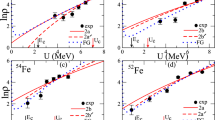Abstract.
A proper treatment of the resonant continuum is to take account of not only the energy of the resonant state, but also its width. The effect of resonant states on pairing correlations is presented in the framework of the relativistic mean-field theory plus Bardeen-Cooper-Schrieffer (BCS) approximation with a constant pairing strength. The study is performed in an effective Lagrangian with the parameter set NL3 for neutron-rich even-even Ni isotopes. Results show that the contribution of the proper treatment of the resonant continuum to pairing correlations for those nuclei close to the neutron drip line is important. The pairing gaps, Fermi energies, pairing correlation energies, and binding energies are considerably affected by a proper consideration of the width of resonant states. The problem of unphysical particle gas, which may appear in the calculation of the traditional mean field plus BCS method for nuclei in the vicinity of the drip line could be well overcome when the pairing correlation is performed by using the resonant states instead of the discretized states in the continuum.
Similar content being viewed by others
References
P. Ring, Prog. Part. Nucl. Phys. 37, 197 (1996).
J. Dobaczewski, W. Nazarewicz, Philos. Trans. R. Soc. London, Ser. A 356, 2007 (1998).
T.T.S. Kuo, F. Krmpotic, Y. Tzeng, Phys. Rev. Lett. 78, 2708 (1997).
J. Dobaczewski, W. Nazarewicz, T.R. Werner, J.F. Berger, C.R. Chinn, J. Dechargé, Phys. Rev. C 53, 2809 (1996).
P. Ring, P. Schuck, The Nuclear Many-Body Problem (Springer-Verlag, Berlin, 1980).
Jun-Qing Li, Zhong-Yu Ma, Bao-Qiu Chen, Yong Zhou, Phys. Rev. C 65, 064305 (2002).
J. Dobaczewski, H. Flocard, J. Treiner, Nucl. Phys. A 422, 103 (1984).
H. Kucharek, P.Ring, Z. Phys. A 339, 23 (1991).
N. Sandulescu, R.J. Liotta, R. Wyss, Phys. Lett. B 394, 6 (1997).
N. Sandulescu, Nguyen Van Giai, R.J. Liotta, Phys. Rev. C 61, 061301(R) (2000).
A.T. Kruppa, P.H. Heenen, R.J. Liotta, Phys. Rev. C 63 044324 (2001).
N. Sandulescu, L.S. Geng, H. Toki, G. Hillhouse, Phys. Rev. C 68 054323 (2003).
Li-Gang Cao, Zhong-Yu Ma, Phys. Rev. C 66, 024311 (2002).
M. Del Estal, M. Centelles, X. Viñas, S.K. Patra, Phys. Rev. C 63, 044321 (2001).
G.A. Lalazissis, J.König, P.Ring, Phys. Rev. C 55, 540 (1997).
G.A. Lalazissis, S. Raman, P. Ring, At. Data Nucl. Data Tables 71, 1 (1999).
Zhong-yu Ma, A. Wandelt, N.V. Giai, D. Vretenar, P. Ring, Nucl. Phys. A 686, 173 (2001).
Zhong-yu Ma, A. Wandelt, N.V. Giai, D. Vretenar, P. Ring, Li-gang Cao, Nucl. Phys. A 703, 222 (2002).
P. Ring, Zhong-yu Ma, N.V. Giai, A. Wandelt, D. Vretenar, Li-gang Cao, Nucl. Phys. A 694, 249 (2001).
Li-Gang Cao, Zhong-Yu Ma, Chin. Phys. Lett. 20, 1459 (2003).
C.J. Horowitz, B.D. Serot, Nucl. Phys. A 368, 503 (1981).
B.D. Serot, J.D. Walecka, Adv. Nucl. Phys. 16, 1 (1986).
J. Boguta, A.R. Bodmer, Nucl. Phys. A 292, 413 (1977).
M. Grasso, N. Sandulescu, Nguyen Van Giai, R.J. Liotta, Phys. Rev. C 64, 064321 (2001).
W. Greiner, Relativistic Quantum Mechanics - Wave Equation (Springer-Verlag, 1997).
P. Bonche, S. Levit, D. Vautherin, Nucl. Phys. A 427, 278 (1984).
J. Meng, Phys. Rev. C 57, 1229 (1998).
G. Audi, A.H. Wapstra, Nucl. Phys. A 595, 409 (1995).
G.A. Lalazissis, D. Vretenar, P. Ring, Phys. Rev. C 57, 2294 (1998).
M.M. Sharma, A.R. Farhan, S. Mythili, Phys. Rev. C 61, 054306 (2000).
Author information
Authors and Affiliations
Corresponding author
Additional information
V. Vento
Rights and permissions
About this article
Cite this article
Cao, LG., Ma, ZY. Effect of resonant continuum on pairing correlations in the relativistic approach. Eur. Phys. J. A 22, 189–197 (2004). https://doi.org/10.1140/epja/i2004-10029-5
Received:
Accepted:
Published:
Issue Date:
DOI: https://doi.org/10.1140/epja/i2004-10029-5




